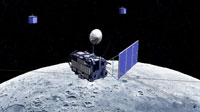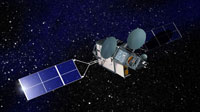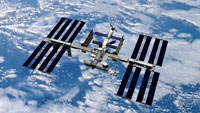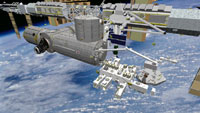
Q. Could you talk about this year’s primary missions?

Japanese Moon Explorer SELENE

Wideband InterNetworking engineering test and Demonstration Satellite (WINDS)

International Space Station

Japanese Experiment Module Kibo

JAXA’s Astronauts
We are planning two domestic launches this year. Setting 2007 as the starting year for lunar exploration, this summer we’re launching the lunar orbiting satellite SELENE (SELenological and ENgineering Explorer), which is the largest lunar exploration mission since Apollo. The United States has announced plans for human lunar exploration, and China and India are progressing with their lunar exploration missions. The whole world is now talking about going to the moon. The purpose of studying the moon is to build a human lunar base. Although it may take 20 years, we’d like to collaborate with other countries to make it happen. SELENE will be our first step.
We are also planning to launch WINDS (Wideband InterNetworking engineering test and Demonstration Satellite) at the end of this year. The satellite will especially benefit our Internet society by enabling speedier communications.
Beside these satellites, this year’s biggest event is that the Japanese Experiment Module Kibo is finally going to launch and dock on the ISS. It will take three launches to complete the Japanese laboratory, two this year and one next year, and then we’ll finally be able to start scientific experiments in space. Astronaut Takao Doi is going to accompany the first launch of Kibo. Japanese astronauts will stay on the ISS for a long time after the completion of the laboratory, so astronauts Koichi Wakata, Soichi Noguchi and others are currently training for future missions.
Q. Are there other areas you would like to focus on this year?
I’d like to continue to emphasize the reliability of our space program, as this is a fundamental issue. In addition, I will focus more on the components of rockets and satellites. Even though many rockets and satellites are produced in the world, the number of manufacturers that make parts for them is limited. Unfortunately, Japanese manufacturers cannot provide all the items, which prevents us from building and launching a satellite when necessary, so I’d like to see improvement in this area.
I’d also like to develop robots that can conduct missions in space. Japan has strength in robotic technologies, so I think we will be able to build robots for lunar and planetary exploration. Our robot team, which was formed last year, will likely start working on development this year.
The Lunar and Planetary Exploration Team was also established last year, and their teams are now looking into lunar exploration and Hayabusa 2, the successor to the asteroid explorer Hayabusa. I think this year we can initiate research on future satellites.
Meanwhile, our next target for aviation is silent supersonic transport. The basic plan was formed last year, and we will move on with experiments toward development this year. However, I don’t think this project will be completed without international collaboration. We need to enhance what we are good at, and contribute to the development of supersonic transport on an international level.
Q. It seems like it’s being demonstrated through many activities that space can play a great role in children’s education. Do you have any future plans in this area?
Two years ago JAXA opened the Space Education Center, which aims to educate children and train teachers so they can introduce space topics in class. We have prepared materials for these purposes, but it’s important to get more teachers interested in space education, as we cannot teach all children in one year by ourselves. This year we’d like to increase training opportunities for teachers.
This by itself won’t be enough to increase the number of space fans, so we also have other plans. JAXA will support and expand the existing Young Astronauts Club, consisting of almost 4,000 members across Japan. We will also launch a space fan club for those who don’t participate in activities but are still interested in receiving information about space. Information will be available online, possibly with a Q&A corner. I think the increase in the number of space fans will ultimately enrich the human resources in Japan’s space program, or at least encourage more interest in science, even though it has been said that the subject is becoming less popular. This space fan club is scheduled to be launched this spring, so please don’t miss it.
| 1 2 3 4 |